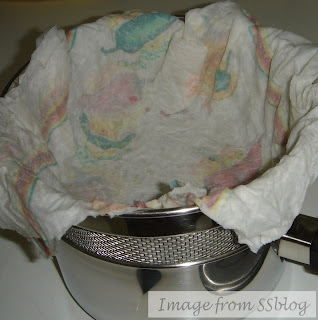I am making paneer today. I will refer to this post later on when I use paneer in spicy or sweet dishes. One new thing I am trying here is using viva brand towels to drain the paneer. Other than that this is just a normal paneer making recipe, so you can feel free to use cheese-cloth instead of these towels.
Fig. 1 Paneer
I really hate using re-used cheese-cloth to squeeze and drain water from paneer. It's not just the chore of washing it, which is quite alright if I wash one piece of cloth by hand. Its more that, after it is dried and I need to use it again, I worry.. how clean did I wash it? I don't like the questionable hygiene of re-used cloth touching food.
I have been using cheese-cloth all these years, it certainly works out well. And I did not know of any other option. I had heard about some sort of plastic paneer-maker thing, but as far as my friends have tried, it doesn't work out well. Recently I saw several advertisements for viva towels being used to make chakka (drain yogurt water), etc. So I wondered if I could give that a shot just once for paneer. It's disposable, presumably cleaner than cloth I have washed by hand. But will tiny pieces/shreds of towel paper get into my paneer? Will the paper towel tear up?
So today I show results from my experiment of using viva towels instead of cheese-cloth to drain paneer. From the picture above you can see that one way or another I did get paneer at the end. ;)
Clarification:
Here I am making paneer for Rasgullas. So the measures for milk and lemon juice and "sitting under weight time" are according to that recipe.
Ingredients:
2% reduced fat milk - 4 cups
Lemon juice - 1/4 cup
Water - roughly 1/4 cup
Procedure:
1) Mix lemon juice and water to dilute the lemon juice. (This I do especially because it lets me use minimum lemon juice while making in the paneer, which is important if you intend to use the paneer for sweet dishes like rasgulla, sandesh, rasmalai, etc.)
2) Now keep milk to boil.
Fig.2 Milk being heated
3) When milk is bubbling, turn off the heat and add the diluted lemon juice. Add gradually. You might not need the entire 1/4 cup of lemon juice. (I didn't, but I'm afraid I cannot estimate how much I might have used on account of it being diluted.)
4) Stop when paneer floats to the top. Liquid below should be translucent. Now its time to drain out the liquid from this paneer.
Fig.3 Paneer floats to the top
5) I doubled two towels, wet them, squeezed out the water. The viva towels held fairly strong when I did that. Then I put them in a steel colander over a vessel (I like to collect the paneer liquid - is it called whey?)
Fig. 4. Towels waiting to drain paneer
6) Pour the paneer with its liquid into the colander. Paneer sits in the towel in the colander. Liquid gets collected in the vessel underneath.
Fig. 5. Towels drain paneer
7) Now I took the colander with paneer and washed the paneer with plain water once or twice (like washing rice or dal.) This is so the lemon flavour rinses out of the paneer. Need to wash well. Otherwise desserts made with the paneer may smell of lemon. (The lemony-ness is usually ok if paneer is being used in savoury dishes.)
8) Now I bundled up the towel with the paneer. I lightly squeezed out the paneer portion first (leaving top empty part slightly loose, but not quite open so as to not allow paneer to fall out from there). Then I squeezed out the top empty portion of the towels. Repeated squeezing out the paneer liquid a few more times till I felt like I have given it my best. If you are too aggressive with this, the towels may tear. They are
not ultra strong.
10) Now I left a heavy weight i.e. pressure cooker (my heaviest item) on top of the squeezed-paneer bundle for about 1 hour (for rasgullas). What did the paneer look like after the allotted 1 hour? Perfect consistency!! (For paneer pic, refer to picture called Fig.1.) No shreds of the towels have found their way into the paneer. And paneer is as dry as it needs to be. Just perfect! If you want to use paneer for some savoury dish, like palak paneer, then you can leave the weight on the paneer for a little longer, say 2 hours in all, to get the paneer to be a little more dry/hard.
Verdict:
Is the viva towels experiment recommended? Umm.. let's see what we have..
Are there shreds of paper in the paneer? No. :)
Do the towels tear?
They could tear if one is not very careful. So ensuring the dryness of paneer is a little bit tricky and requires a small amount of judgement.
So yes, I will use the viva towels again.
Something to note for future, I should get towels without coloured drawings on them. Who knows what kind of colour they use.. how fast it may be.. could be going into the paneer from the towels! Was not obvious here.
Feel free to weigh your options. My duty was to tell the world about my experiment. Spread information. Job done!
Happy cooking everyone!!












